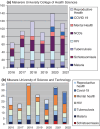Identification of training needs in schistosomiasis research to build capacity for schistosomiasis control in Uganda
- PMID: 40018823
- PMCID: PMC11964987
- DOI: 10.1111/tmi.14098
Identification of training needs in schistosomiasis research to build capacity for schistosomiasis control in Uganda
Abstract
Background: Schistosomiasis is the leading cause of fatal upper gastrointestinal bleeding among adults in East Africa. The prevalence among school-aged children in villages along the Albert-Nile shoreline in North-Western Uganda is estimated at 85%. Efforts to control schistosomiasis in low- and-middle-income countries remain limited due to an incomplete understanding of the pathogenesis, disease manifestations, transmission mechanisms, preventive measures and interventions. In addition, there is insufficient capacity to analyse, model and predict relevant clinical case management systems, biological interventions and disease control efforts. We conducted a needs assessment for schistosomiasis research training at academic and research institutions in Uganda to inform the development of a structured training programme to build capacity to conduct locally relevant research to control the disease.
Methods: Using an online survey, we collected data on training needs, potential trainees, available resources including local and international collaborations, as well as priority areas for schistosomiasis research and training at academic and research institutions in Uganda. Data were analysed and presented in frequency tables and figures.
Results: Overall, schistosomiasis had the lowest number of studies conducted, based on the studies approved by research ethics committees at the two leading medical schools in Uganda: Makerere University College of Health Sciences (MakCHS) and Mbarara University of Science and Technology (MUST) between 2016 and 2022. The top ranked schistosomiasis focus areas of interest, by scientists at MakCHS, MUST, the Vector Borne and Neglected Tropical Diseases Division of the Ministry of Health and the Uganda Virus Research Institute (UVRI), were schistosomiasis prevention and transmission, vector biology, diagnostics, treatment and clinical trials, respectively. The top ranked training needs were schistosomiasis prevention and control, research ethics, data analysis, epidemiology and research methods (quantitative and qualitative), malacology, infectious diseases modelling, scientific writing and communication skills.
Conclusion: Priority areas for schistosomiasis research and training will be utilised to develop a robust, collaborative, multidisciplinary schistosomiasis research training programme, to increase the critical mass of scientists with the competencies required to design, execute and utilise schistosomiasis biology, clinical, laboratory and epidemiology research to advance disease control interventions and minimise/eliminate schistosomiasis-associated morbidity and mortality in sub-Saharan Africa.
Keywords: Uganda; capacity building; malacology; research training; schistosomiasis; sub‐Saharan Africa.
© 2025 The Authors Tropical Medicine & International Health published by John Wiley & Sons Ltd.
Conflict of interest statement
The authors declare that they do not have any conflicts of interest.
Figures



Similar articles
-
Career development for infection and immunity research in Uganda: a decade of experience from the Makerere University - Uganda Virus Research Institute research and training programme.AAS Open Res. 2020 Aug 17;3:26. doi: 10.12688/aasopenres.13066.2. eCollection 2020. AAS Open Res. 2020. PMID: 32734140 Free PMC article.
-
Exploring healthcare professionals' perspectives on neglected tropical diseases in Eastern Uganda: a qualitative study with a focus on schistosomiasis and soil-transmitted helminths.Trans R Soc Trop Med Hyg. 2024 Dec 3;118(12):781-789. doi: 10.1093/trstmh/trae043. Trans R Soc Trop Med Hyg. 2024. PMID: 39115255
-
Makerere University-Uganda Heart Institute collaborative cardiovascular disease training and research since 1988.Afr Health Sci. 2022 Aug;22(Spec Issue):68-70. doi: 10.4314/ahs.v22i2.11S. Afr Health Sci. 2022. PMID: 36321124 Free PMC article.
-
Spatial distribution of schistosomiasis and treatment needs in sub-Saharan Africa: a systematic review and geostatistical analysis.Lancet Infect Dis. 2015 Aug;15(8):927-40. doi: 10.1016/S1473-3099(15)00066-3. Epub 2015 May 21. Lancet Infect Dis. 2015. PMID: 26004859
-
Health-seeking behaviour regarding schistosomiasis treatment in the absence of a mass drug administration (MDA) program: the case of endemic communities along Lake Albert in Western Uganda.BMC Public Health. 2023 Jun 5;23(1):1072. doi: 10.1186/s12889-023-16020-z. BMC Public Health. 2023. PMID: 37277773 Free PMC article. Review.
References
-
- WHO Team Neglected Tropical Diseases . Ending the neglect to attain the Sustainable Development Goals: A road map for neglected tropical diseases 2021–2030. 2021. [cited 2025 Feb 21]. Available from: https://www.who.int/publications/i/item/9789240010352
-
- Nelson GS. Schistosoma mansoni infection in the West Nile District of Uganda. IV. Anaemia and S. mansoni infection. East Afr Med J. 1958;35(10):581–586. - PubMed
-
- Gryseels B, Polman K, Clerinx J, Kestens L. Human schistosomiasis. Lancet. 2006;368(9541):1106–1118. - PubMed
MeSH terms
Grants and funding
LinkOut - more resources
Full Text Sources

